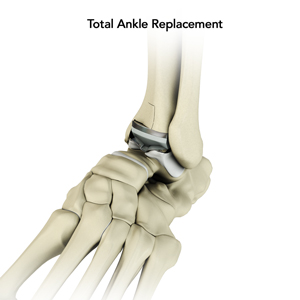Total Ankle Replacement
Ankle Joint Replacement Surgeon in Camarillo, CA

Severe end-stage arthritis that has not responded to non-surgical treatments is usually treated with a surgical procedure called ankle joint replacement. The procedure can relieve your pain and increase the mobility of the ankle joint. Dr. Brady provides expert diagnosis and individualized non-operative and operative treatments for the ankle including ankle joint replacement in California. Dr. Brady also provides highly specialized care during and after surgery. Contact Dr. Brady’s team for an appointment today!

What is Ankle Joint Replacement Surgery?
Ankle joint replacement, also known as total ankle arthroplasty, is a surgical procedure performed to relieve pain and immobility due to severe end-stage arthritis that has not responded to non-surgical treatments. The goal of ankle joint replacement surgery is to eliminate your pain and increase the mobility of your ankle joint.
Ankle joint replacement is also recommended for the elderly with a severe fracture from osteoporosis, or presence of a tumor in the ankle joint.
What is Ankle Arthritis?
The ankle joint connects the leg with the foot and provides free movement to the foot. It is formed by connecting the bones of the lower leg, tibia, and fibula, with the talus, or ankle bone.
The surfaces of the ankle bones are covered with articular cartilage. Damage to this leads to a condition called arthritis, which results in pain and impaired movement of the ankle.
Infection, bone fracture, connective tissue disorder, excessive stress, and certain disease conditions such as rheumatoid arthritis and osteoarthritis can cause ankle arthritis.
How is Ankle Arthritis Diagnosed?
Ankle arthritis is diagnosed by your physician after reviewing your history and performing an examination of the symptomatic ankle. Imaging studies such as X-ray and MRI may be ordered to confirm the diagnosis.
What are the Treatment Options for Ankle Arthritis?
Conservative treatment of ankle arthritis involves oral medications and joint injections. However, if you are unresponsive to these treatments, a total ankle replacement or ankle fusion is recommended.
How is an Ankle Joint Replacement Performed?
Ankle joint replacement surgery is performed under general anesthesia. Your surgeon makes an incision over the front of the ankle. The muscles are retracted, and tendons and ligaments moved away to expose the ankle joint. The damaged regions of the tibia and talus bones are then removed using special instruments, and the remaining healthy bones are reshaped to fit an artificial joint or prosthesis. A bone graft is inserted between the tibia and fibula to create a fusion of the two bones and prevent loosening of the prosthesis. The prosthetics are kept in position with special bone cement and instrumentation such as screws to support the artificial ankle. The artificial ankle joint is placed into the space that has been cut to fit it perfectly.
What is the Postoperative Care for an Ankle Joint Replacement?
Following ankle joint replacement, you may need to stay in the hospital for 2-3 days and will be advised on certain precautionary measures to be followed for a successful recovery.
Swelling and discomfort can be managed with prescription pain medicines, applying ice packs, and by elevating your ankle above heart level while resting.
The treated ankle will be immobilized in a bulky splint that needs to be kept clean, dry and intact. You are advised not to bear weight on the ankle for at least 6-8 weeks and use crutches, walker or wheelchair. Sutures are removed after 14-21 days.
You will be referred to physical therapy once the incision is nicely healed to begin working on range of motion.
You should avoid smoking, alcohol consumption, and should eat a healthy diet for the best outcome.
What are the Risks and Complications of Ankle Joint Replacement?
As with any major surgery, there are potential risks involved. The possible complications associated with ankle joint replacement include infection, fracture of the tibia or fibula, dislocation of the ankle, damage to nerves or blood vessels, blood clots (DVT or deep venous thrombosis), loosening of artificial components, failure to relieve pain, instability, and stiffness.
If you would like to have additional information on the treatment of ankle joint replacement, please contact Coastal Orthopaedic and Spine Institute, serving the communities of Camarillo, CA.
